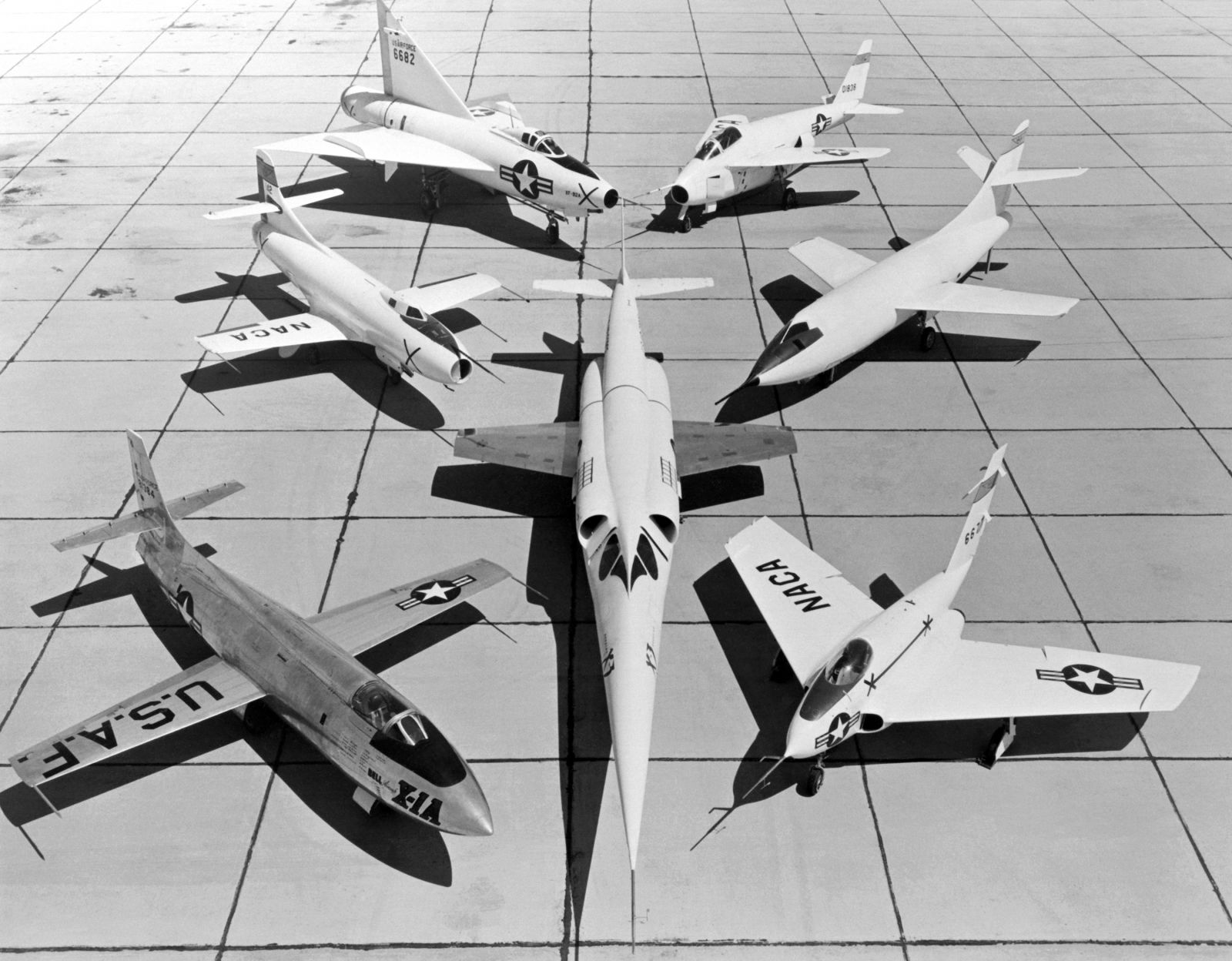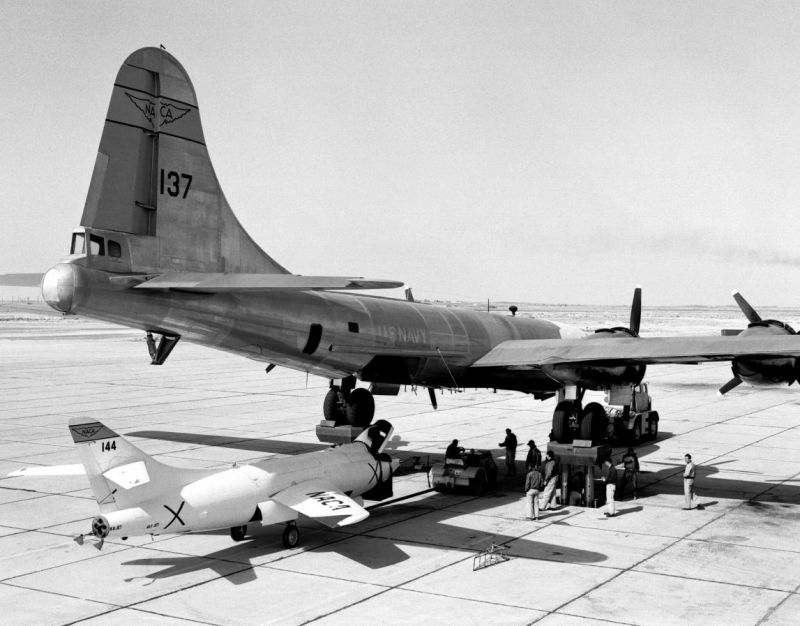
NACA High-Speed Flight Research Station, 8/4/53
Arranged for a publicity shot are seven of NACA’s hottest manned X-Planes and other research aircraft of the early to mid Fifties. Clockwise from the top, they are the Bell X-5, Douglas D-558-2 Skyrocket, Northrop X-4 Bantam, Douglas X-3 Stiletto, Bell X-1A, D-588-1 Skystreak, and Convair XF-92. The aircraft were flown by a variety of contractor, NACA and USAF pilots during their time at Edwards AFB.
The Bell X-5 was built to test variable wing sweep, and was the first aircraft to be able to change its sweep in flight. Bell partially based the X-5 on the Messerschmitt P.1101, which could be set to different sweep angles prior to flight. The X-5's wings could be switched between three positions: 20°, 40° and 60°, utilizing a jackscrew assembly to move the hinge along rails and disc brakes to hold the wing in the desired position.

Moving from full sweep to minimum sweep or vice-versa took less than thirty seconds, and the motion of the hinge and pivots partially compensated for the CG change. The design did suffer from an otherwise poor aerodynamic layout however, with the tail and vertical stab being inadequate, and a bad tendency to enter an unrecoverable spin at certain sweep angles. One of the two X-5s built was lost after such a spin, and the pilot was killed. The other continued testing until 1955, and was used as a chase plane until 1958 after which it was delivered to the USAF Museum in Dayton.
The D-558-2 was a the second aircraft a planned three stage plan, with the jet-powered D-558-1 being the first phase, and the unbuilt pure rocket 558-3, originally conceived to explore hypersonic speeds. The Skyrocket built by Douglas for the US Navy, and was famously flown by Scott Crossfield, who became the first person to exceed Mach 2 in 1953, less than a month before the 50th anniversary of First Flight at Kitty Hawk. Originally using a J34-40 turbojet to takeoff and a Reaction Motors XLR-11 rocket engine (same as the X-1) for high-speed flight, the first two Skyrockets were later switched to pure rockets (#3 continued life as mixed-propulsion experiment), and were carried aloft by a Navy P2B patrol bomber (the Navy’s version of the Boeing B-29).

Over 8 years and 313 flights the three Skyrockets researched a variety of wing-fence, wing-slat and leading edge chord extension configurations, all designed to improve stability and maneuverability of transonic and supersonic aircraft, as well as the effect of various external stores (bombs and fuel tanks) on the aircraft’s behavior. All three D-558-2s survive, with D-558-2 #1 Skyrocket is on display at the Planes of Fame Museum, Chino, California, number two Skyrocket, the first aircraft to fly Mach 2, on display at the National Air and Space Museum in Washington D.C., and #3 aircraft on a pylon in the grounds of Antelope Valley College, Lancaster, California.
Northrop’s X-4 Bantam was designed to explore the stability of a semi-tailless planform at high-speed. Resembling the WW2-era Me 163 Komet and post-war DH.108 Swallow, the Bantam was built only big enough to hold the two J-30 jets, necessary instruments, a 45-minute fuel supply and pilot. The X-4 proved the opposite of its expected goal, suffering from pitch oscillation, tucking, and a tendency to “hunt” about all three axes. Various attempts were made to improve stability, but, mainly due to the primitive flight controls of the time, a permanent fix was never found, and the type was retired after six years and only 100 or so flights. The second X-4 is on display at the USAF Museum, and the first (which only flew for contractor flights and was retained as a spares source) has been restored and will go on display at the Air Force Flight Test Museum when it opens in December 2021 (or there abouts).
The Douglas X-3 Stiletto was designed to test aircraft shaping for sustained supersonic speed, mainly a long, narrow fuselage and nose, and slender, low aspect ratio wings. Douglas expected the X-3 to reach 2,000 mph, however the experimental J46 engines did not develop, and so J34 engines were substituted, despite being half the expected thrust of the former jets. The Stiletto was considered a failure in its primary mission, being too underpowered to reach Mach 1 in level flight. The aircraft also had a high take-off speed as was difficult to control. The program did result in data on inertia coupling, and Lockheed also utilized the X-3's data when developing the F-104 Starfighter. The sole Stiletto is on display at the USAF Museum.
The Bell X-1A was a follow-on to the X-1, famously flown by Chuck Yeager to Mach 1 just a year prior. The X-1A was designed to explore higher speeds, and was heavier and longer than its predecessor. The plane also had a new windscreen for better pilot visibility. Dropped from a B-29 or B-50, the X-1A, with Yeager at the controls, set a new record of Mach 2.44 at 74,700 feet, though he later lost control of the plane as a result of inertia coupling. The X-1A plummeted to 25,000 while Yeager struggled to regain control, during which his helmet broke the canopy. A year later, Maj. Arthur Murray took the X-1A to 90,440 feet. In 1955 the X-1A was lost after an explosion, later traced to a chemical reaction between the liquid oxygen and a treating agent in the Ulmer leather gaskets. Pilot Joe Walker was able to escape the plane, which was then jettisoned from the RB-50.
The Douglas D-558-1 Skystreak was a jet-powered airplane to explore transonic flight as part of a joint NACA/Navy program. Equipped with a GE/Allison J35 engine, the Skystreak was still aerodynamically a product of WW2-era thinking, and featured unswept wings. Nevertheless, D-558-1-1 set an airspeed record in early 1947 of 640.744mph, later bested by -2 aircraft 5 days later. The Skystreak reached Mach 0.99 in level flight, but could only break Mach 1 in a dive, and was overshadowed by the Bell X-1. The Skystreak did provide invaluable research on high subsonic speed and loading, and while -2 was destroyed in a crash, the first plane is on display at the National Naval Aviation Museum at NAS Pensacola, and -3 is at the Carolinas Aviation Museum at Charlotte-Douglas Int’l Airport.
The Douglas XF-92 was built as the prototype of a point-defense interceptor, but after the project was canceled the plane was turned over to NACA for testing. The aircraft was constructed from many existing components to save time, the main gear was taken from a North American FJ-1 Fury, the nosewheel from a Bell P-63 Kingcobra, the engine and hydraulics were taken from a Lockheed P-80 Shooting Star, the ejection seat and cockpit canopy were taken from the cancelled Convair XP-81, and the rudder pedals were taken from a BT-13 trainer. The airplane was found to be underpowered and difficult to control, though Chuck Yeager did manage to get it to Mach 1.05. On the last flight, the nose gear collapsed as Scott Crossfield taxied the plane off the lake bed. The plane did generate data on delta wings, which was later used on other Convair products such as the F-102, F-106, B-58 and the canceled F2Y and FY.